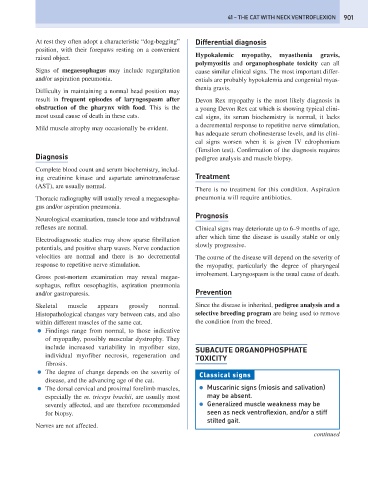Page 909 - Problem-Based Feline Medicine
P. 909
41 – THE CAT WITH NECK VENTROFLEXION 901
At rest they often adopt a characteristic “dog-begging” Differential diagnosis
position, with their forepaws resting on a convenient
Hypokalemic myopathy, myasthenia gravis,
raised object.
polymyositis and organophosphate toxicity can all
Signs of megaesophagus may include regurgitation cause similar clinical signs. The most important differ-
and/or aspiration pneumonia. entials are probably hypokalemia and congenital myas-
thenia gravis.
Difficulty in maintaining a normal head position may
result in frequent episodes of laryngospasm after Devon Rex myopathy is the most likely diagnosis in
obstruction of the pharynx with food. This is the a young Devon Rex cat which is showing typical clini-
most usual cause of death in these cats. cal signs, its serum biochemistry is normal, it lacks
a decremental response to repetitive nerve stimulation,
Mild muscle atrophy may occasionally be evident.
has adequate serum cholinesterase levels, and its clini-
cal signs worsen when it is given IV edrophonium
(Tensilon test). Confirmation of the diagnosis requires
Diagnosis pedigree analysis and muscle biopsy.
Complete blood count and serum biochemistry, includ-
ing creatinine kinase and aspartate aminotransferase Treatment
(AST), are usually normal.
There is no treatment for this condition. Aspiration
Thoracic radiography will usually reveal a megaesopha- pneumonia will require antibiotics.
gus and/or aspiration pneumonia.
Prognosis
Neurological examination, muscle tone and withdrawal
reflexes are normal. Clinical signs may deteriorate up to 6–9 months of age,
after which time the disease is usually stable or only
Electrodiagnostic studies may show sparse fibrillation
slowly progressive.
potentials, and positive sharp waves. Nerve conduction
velocities are normal and there is no decremental The course of the disease will depend on the severity of
response to repetitive nerve stimulation. the myopathy, particularly the degree of pharyngeal
involvement. Laryngospasm is the usual cause of death.
Gross post-mortem examination may reveal megae-
sophagus, reflux oesophagitis, aspiration pneumonia
and/or gastroparesis. Prevention
Skeletal muscle appears grossly normal. Since the disease is inherited, pedigree analysis and a
Histopathological changes vary between cats, and also selective breeding program are being used to remove
within different muscles of the same cat. the condition from the breed.
● Findings range from normal, to those indicative
of myopathy, possibly muscular dystrophy. They
include increased variability in myofiber size,
SUBACUTE ORGANOPHOSPHATE
individual myofiber necrosis, regeneration and
TOXICITY
fibrosis.
● The degree of change depends on the severity of
Classical signs
disease, and the advancing age of the cat.
● The dorsal cervical and proximal forelimb muscles, ● Muscarinic signs (miosis and salivation)
especially the m. triceps brachii, are usually most may be absent.
severely affected, and are therefore recommended ● Generalized muscle weakness may be
for biopsy. seen as neck ventroflexion, and/or a stiff
stilted gait.
Nerves are not affected.
continued

